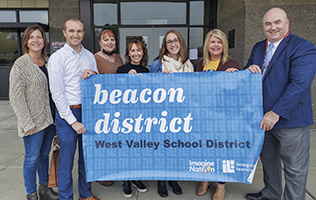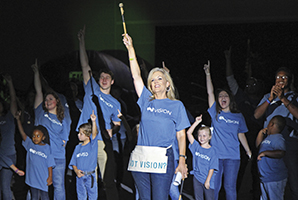Points of Light for Learning 2025
March 01, 2022
School districts serve as demonstration sites to ‘light the path to the rest of the country’

School administrators looking for ways to redesign public education will want to check out schools like Manor New Technology High near Austin, Texas.
The school’s 575 students take conventional courses but learn in unconventional ways.
Each is issued an iPad and works with class-mates around tables. Groups carry out real-world projects often linked to local high-tech industries such as Samsung Austin Semiconductor. Classes are noisy as students debate ideas and solve problems. They
collaborate on more than 50 projects a year. Virtually all — 102 of the 103 seniors last year — graduate.
“Everyone loves it,” says André Spencer, in his second year as superintendent of Manor Independent
School District after leading schools in New York City and Colorado Springs, Colo. “It works.”
Equitable Preparation
Manor New Technology High offers one on-the-ground example of what it looks like to engage in future-driven practices, one of 11 key objectives in the initiative launched a year ago by AASA’s Learning 2025: National Commission on Student-Centered, Equity-Focused Education. More than 100 school system, business and nonprofit leaders are enlisted in this effort to
create a new vision for public schools.
AASA created the coalition to more equitably prepare all students to thrive in the workplace and society of the future. The disruptive forces of a global pandemic, economic volatility and civil unrest
created a “cultural tipping point” for change and bold ideas, said Daniel A. Domenech, AASA executive director and co-chair of the commission, in a Learning 2025 webinar.
The commission’s report, “An American Imperative: A New Vision of Public Schools,” released last April, defines objectives educators should strive for. The commission envisions a “holistically
redesigned school system” in which culture, resources and social, emotional and cognitive growth are interrelated — a “learning ecosystem” supported by educators, students, families and the community.
This new system’s
future-driven culture centers on personalized education for the whole learner. No student would be marginalized. In addition to tests, educators would rely on other evidence of learning, such as portfolios, demonstrations and rubrics, to capture learners’
full social, emotional and cognitive growth. Educators would assess learners on a growth model continuum, working with data analysis, planning, learning and evidence of learning in a continuous feedback loop.
Students would have quality
preschool, technology that accelerates their learning, and resources and connections in the community. Diverse educator hiring
pipelines would ensure all are guided by faculties who reflect them. All teaching and learning would be reoriented around the individual learner, who would become the “co-author” of his or her learning journey.
Paving Pathways
The 9,600-student Manor Independent School District and others are demonstration sites for practices that fulfill Learning 2025’s objectives. These districts can “light the path to the rest of the country,” says school leadership expert
Bill Daggett, the commission’s other co-chair.
Since July, superintendents engaged in the Learning 2025 network of 115 school systems have met twice a month to share strategies and success. They’ve also exchanged ideas on blogs,
in newsletters and through case studies and videos of best practices.
Fifteen senior consultants coach and advise superintendents as thought partners and “concierges” to help them advance the Learning 2025 strategic vision,
says Steve Webb, one of the consultants and former superintendent of the Vancouver Public Schools in Washington, in an e-mail. Network districts are “on continuous improvement journeys,” Webb says. “This is more about mindset, policy
informed by practice and a hopeful aspirational vision for public education in America.”
Student Centeredness
Learning 2025 is revealing points of light across the nation. One is the West Valley School District in Yakima, Wash. The district is making headway on many Learning 2025 objectives as it gives its 5,000 students, a third of them Latino, what it calls
ownership over an education focused on the whole learner. And it starts earlier with preschool at all six elementary schools.
“We have incredible focus on early learning,” says Peter Finch, who’s in his first year as superintendent
after 20 years as assistant superintendent.
All children enter kindergarten ready to learn, he says. Once there, and later in 1st grade, they can in some ways learn at their own paces as they earn badges for gaining skills, such as learning
letter sounds or how to compare and contrast a story.
The district’s Stronger Together initiative brings together administrators, staff, families and community resources in a focus on equity. The program strives to remove systemic
barriers and increase opportunities with the goal of success for all students.
West Valley also has broadened its core curriculum with fine arts, music and social and emotional learning. Fifth graders learn musical notation and compose
music to play to classmates.
This school year, the district launched a middle school innovation center where students explore career interests in health science, computer science or engineering. The project-based program allows students to advance at their own paces.
It flows into the high school’s Futures program, which clusters classes by career interests.
West Valley teachers at all levels use a station rotation instructional style, moving small groups of students among learning posts, either
in one day or over several days. In high school history, students might rotate to one station to analyze a primary document, to another to watch a video independently on a Chromebook issued to every student and to a third for a small-group discussion
with the teacher.
The rotation approach makes learning more “meaningful and relevant” and allows teachers to work with small groups, Finch says.
Through partnership with Yakima Valley College, the district also supports
a diverse educator pipeline that puts bilingual student teachers in classrooms a full year, helping build a faculty that reflects students’ diversity.
West Valley’s efforts to focus on the whole learner have paid off, literally,
for students who earn money in apprenticeships and for more students earning college credit in high school, more going to college, and dramatically fewer requiring remedial classes in math and English when they get there.
.jpg?sfvrsn=440b1d1b_7)
Emotional Support
In Jonesboro, Ga., south of Atlanta, Clayton County Public Schools strives to make learning more personal and holistic for its 52,000 students, 71 percent of whom are Black. One way it’s doing that is to give unusual attention to social and emotional
learning, says superintendent Morcease Beasley, who has led the district since 2017.
Every teacher in every school starts every class with an emotional support activity, says Beasley. So before plunging into Macbeth, he says, an English
teacher might ask students what in the last 24 hours has made them happy and sad and how did they process those emotions. A 5th-grade teacher at one of the district’s 38 elementary schools may begin class by asking students how their friends
make them feel safe and loved. The aim is to build students’ self-awareness and self-management, Beasley says.
With help from teachers, counselors and psychologists, students learn how to recognize and manage their emotions, develop
empathy and maintain positive relationships.
“We want them to learn at very high levels,” Beasley says, “but first they have to be ready to learn.”
Beasley believes the district’s social and emotional
learning, a core component of the Learning 2025 vision, produced precipitous drops in discipline referrals, suspensions and tribunals both before and after schools closed for the pandemic during 2020. For example, during the first six weeks of school,
the number of tribunals, in which student panels set consequences for student misbehavior, dropped from 34 in 2019 to nine in 2021.
Emphasizing Engagement
Manor New Technology High in Texas has found keys to engage students with its future-driven STEM and project-based lessons. One middle and four elementary schools feeding into it have adopted the same approaches.
Through projects often tied
to career interests and technology, these schools engage students in relevant learning they help shape. Students are co-authors of their learning journeys with teachers as guides.
The school’s students, mostly minorities and about
half Latino, experience an empowered engagement. In a medical microbiology class, they launch an oral health project that leads to their comic strip creations about good oral hygiene. Students in senior English act out scenes from Shakespeare’s
Othello that they have rewritten in today’s language. Many projects are interdisciplinary. Engineering students, for example, design a medieval castle that correlates with their Renaissance lessons in social studies.
Students are
evaluated not only on academics, but also on their work ethic and on their communication and collaboration skills.
The high school has few discipline problems, says Principal Bobby Garcia, and its high achievement has extended to new fine
arts and sports programs that became competitive quickly. Teachers are highly invested and want to stay, giving New Tech High a more than 90 percent teacher retention rate.

Stemming Marginalization
Richardson Independent School District in Texas, which serves part of Dallas, is pioneering ways to carry out Learning 2025’s core mission to design “student-centered, equity-focused education.” Its equity work also shows how meaningful
change in education often stirs controversy and resistance.
The district serves 38,000 students, more than half economically disadvantaged, 39 percent Latino, 22 percent African American and 7 percent Asian American. Parents speak 90 different
languages.
Shortly after she became superintendent five years ago, Jeannie Stone concluded, “We need to adjust our system to embrace that diversity.”
Within a year, she created Richardson’s Department of Equity, Diversity
and Inclusion, which grew from one to six employees. Under the department’s leadership, the district expanded preschool for disadvantaged students and added buses to get them there. It recruited diverse teachers and administrators. It launched
an Accelerated Campus Excellence plan at four struggling elementary schools.
The district established a racial equity committee with 10 subcommittees involving 100 stakeholders devoted to dismantling systemic racism. It trained leaders
in hiring bias, created Black history and Mexican American studies courses and trained teachers in cultural competency and the school board in equity.
The equity department acted in nine areas, including student performance, discipline
and special education, to eliminate disproportionate outcomes by race. The gifted and talented program revamped how it identifies candidates to capture a more representative portion of minority and disadvantaged students. Consequently, the share of
students of color in 12 key schools climbed over the last year from 4 to 9 percent.
Named Texas Superintendent of the Year in 2017 and 2019 by two statewide professional organizations, Stone turned the district’s vision of becoming
a place where all students connect, learn, grow and succeed into a rallying cry: “All Means All.” But critics objected to the way racism was being addressed in schools, and also took issue with the district’s mask mandate for controlling
COVID-19. In December, the school board and Stone agreed it was best for her to resign.
Continuum of Change
No school district, of course, has fully realized the Learning 2025 commission’s vision of an education system where no student is marginalized and every student graduates prepared for success in college or work. No one is even sure what that system will look like.
The commission says the system must be nimble, fluid, technologically advanced and more connected to the community and world. Building it will
demand breaking the constraints of a graded school system loaded with standards and high-stake tests and disrupted by COVID-19.
Learning 2025 school districts are moving on a continuum toward the initiative’s vision, says Webb, the
former superintendent and commission member.
“They are simply thrilled to be learning together,” he says. “We co-design this. Together. A rising tide lifts all boats. That’s a hopeful vision.”
Author
Connecting Learning to the Community and Beyond
Many school districts in AASA’s Learning 2025 network are finding one way to engage students and make learning more personal, relevant and
joyful is to connect it to communities and the world.
Outside Austin, Texas, the Manor Independent School District’s high-tech STEM schools focus on instruction shaped by students and tied to real-world problems. After seeing the success
of those schools in engaging students, other district schools are moving in the same direction, says Superintendent Andre Spencer.
Students in one middle school are solving problems with artificial intelligence. In another, they use digital
technology in fine arts. In one high school, students have a courtroom to explore the law, a beauty shop to practice cosmetology and a television studio to try broadcasting. The district now is exploring ways for students to spend time with professionals
or industries in the community during the school year and as summer interns.
Career Studies
West Valley School District in Yakima, Wash., has been doing that for years. Students in its Futures program take classes
clustered around a career interest. Students can prepare for future studies in sports medicine through the district’s Futures Allied Health program.
Other high school students enter apprenticeship programs, earning as much as $30,000
a year. Some seniors split their days between school and training to be machinists at nearby Pexco Aerospace, a company that makes polymer fixtures for aircraft interiors.
This year, the district launched a middle school innovation center in
which students explore career interests in health science, computer science or engineering. The standards- and project-based program allows them to advance at their own paces.
Naperville Community Unit School District, which enrolls 16,500
students about 25 miles west of Chicago, helps its high school students explore and prepare for their future in work and college. The schools carefully track students’ engagement as they explore potential careers, build digital portfolios and earn
college credit. Surveys and focus groups ensure no student is forgotten or marginalized, says superintendent Dan Bridges.
The goal is to see “all students are feeling as though they are heard and their needs are being met,” he says.
Ninety-eight percent of Naperville’s students graduate and 97 percent of those attend college.
Learning 2025: Beyond the Standard Reform Movement
School administrators have faced repeated calls to fix U.S. public schools since 1983 when President Ronald Reagan’s administration issued
“A Nation at Risk: The Imperative for Educational Reform.”
The report warned our schools’ mediocre performance threatened the nation’s capacity to compete in world commerce, science and technological innovation. It spurred
reform initiatives at every level. Whole-school reforms, such as the Coalition of Essential Schools and charter schools, emerged. The National Center on Education and the Economy designed a standards-based reform plan followed by many states. Congress
in 2001 passed the No Child Left Behind Act, giving rise to high-stakes tests.
Now AASA has issued a new American imperative outlined by its Learning 2025: National Commission on Student-Centered, Equity-Focused Education. The commission identifies
objectives we’ve seen before, such as making learning more personal, relevant, engaging and holistic.
But administrators among the 115 school districts in the Learning 2025 network say this initiative differs from previous movements.
Rather than a plan dictated from on high, they say, it outlines a collective journey shared by participating districts toward a set of objectives.
“Instead of being top down, it’s bottom up,” says Morcease Beasley, superintendent
of Clayton County Public Schools in Jonesboro, Ga. “It is not what they expect us to do. It is what we expect ourselves to do.”
Spreading Practices
The initiative is highlighting bright spots across the
nation, which will help spread best practices and collaborative problem solving that will make education stronger, says Steve Webb, Learning 2025 commission member and former superintendent of Vancouver Public Schools in Washington.
“Leaders
who have joined the Learning 2025 Network are enthusiastic about sharing how they are moving along the continuum toward becoming more learner-centered, equity-driven and future-focused,” he says in an e-mail. “These leaders recognize the power
of learning networks to create lasting and sustainable change for the better.”
Jeannie Stone, who served until mid-December as superintendent of Richardson Independent School District near Dallas, says Learning 2025 has a more positive
focus on what’s possible in education. School leaders and teachers don’t want to hear about putting kids and the nation at risk or leaving children behind, she says. Learning 2025 views change through the educator’s lens, empowering
administrators to find new school and learning designs.
“It’s really about a supportive culture,” she says.
A Deep Dive
While superintendents participating in Learning 2025 may differ
on details of school system redesign, they all agree it must be dramatic.
Administrators in the relatively affluent Naperville Community Unit School District near Chicago, for example, are taking what they consider “a deep dive”
into how they organize the system and the school day for 16,500 students, says superintendent Dan Bridges, who has led the district for a decade.
“Our narrative this year is centered on being bold,” he says. “We have to rethink
our system and what we are doing.”
Advertisement
Advertisement
Advertisement
Advertisement



